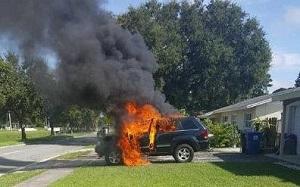Lithium-ion batteries are back in the spotlight this week. Samsung’s brand new flagship smartphone, the Galaxy Note 7, is undergoing a global recall that is estimated to cost the company $1 billion. The President of Samsung’s mobile business department Dongjin Koh told reporters that there was a “tiny problem in the manufacturing process” that caused the phones’ batteries to catch fire. In a YouTube video posted by a man named Ariel Gonzalez, the damage the battery fire causes to the phone can be seen:
The video shows only one of the 35 known cases of ill-manufactured batteries in the Note 7 series. No injuries as a result of the Galaxy Note 7 battery fires have been reported.
However, according to ClassAction.com, three months before the Galaxy Note 7 recall, a Galaxy S7 Edge caught fire in the pocket of a construction worker in Ohio. The man in question has now filed a product liability lawsuit against Samsung for the third-degree burns he suffered due to the phone catching fire.
Samsung is now asking the media to be patient as they fully investigate the battery flaws. The official answer given to media and the public right now is the aforementioned “battery manufacturing flaw”.

Nonetheless, media speculations have already pointed the finger at “thermal runaway”. Previously, a rare condition for lithium-ion batteries, thermal runaway has been reported in several industries that utilize lithium batteries. What happens is, a battery gets overheated to the point where the heat reaches temperatures it can no longer contain. Once the battery gets hotter at a faster rate than it, itself, can produce and absorb heat, a fire or explosion is sometimes likely. Lithium-ion batteries are used in smartphones, laptops, pacemakers, watches, e-cigarettes, and cars. The most alarming case of thermal runaway was reported in September of 2013 when the lithium batteries inside a Boeing 747 caught fire. Qantas, Jetstar, and Virgin Australia (along with a cautionary word from the Federal Aviation Authority) have ordered Galaxy Note 7 owners to switch their phones off inside their aircraft. Not only are aircraft at risk, so are cars. A family’s Jeep was destroyed after the phone exploded inside the vehicle, leading to a much larger fire. The family confirmed that the phone was charging in the center console of the Jeep when the 
Donald Finegan, a chemical engineer at the University of College London explains what happens to phones that suffer from thermal runaway when charging. He said: “The battery can continue to charge and can become even more unstable and eventually just burst into flames itself, without any kind of external heating. The snowball effect happens so fast that, within a second, the entire cell goes from being intact to being completely destroyed.”
The new Note 7’s with the battery flaw being fixed will start shipping on September 19th. How will you know you’re getting one with the new battery? Samsung says that they will be putting a sticker with a blue ‘S’ on the box, which will clearly identify the fixed range of smartphones. They will also launch an online service where customers can insert their IMEI numbers and check whether or not their phone is pre-recall or post-recall. The service will cross-check a database of IMEI numbers and inform a user whether or not they are using a phone that needs to be replaced due to the battery flaw. Samsung said they would start replacing the faulty phones by the 19th of September, 2016.
Samsung confirmed that for pre-recall Galaxy Note 7’s they would be rolling out an update that prevented the phone from charging beyond 60% in hopes that they become less fire-prone.
Lithium-ion batteries are growing in importance in the world we live in today. It is paramount for engineers to figure out how to design them in safer ways. Watch this video below to see how this might be possible:


